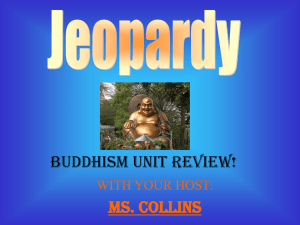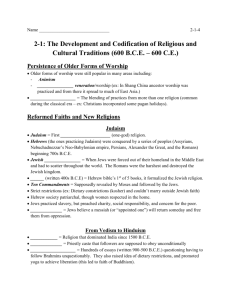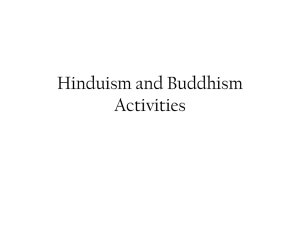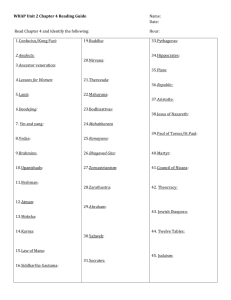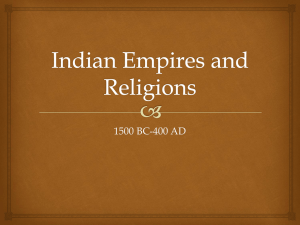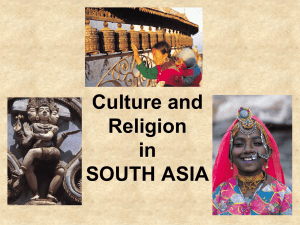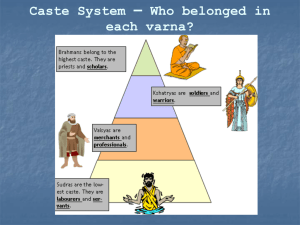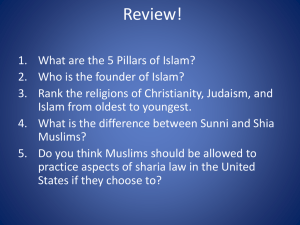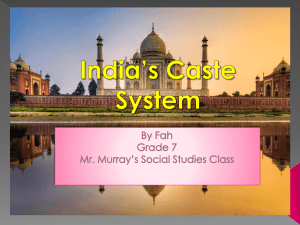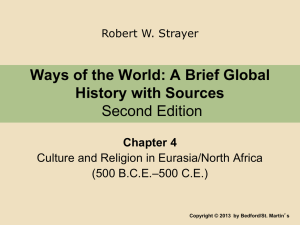Key Concept 2.1 The Development & Codification of Religious
advertisement
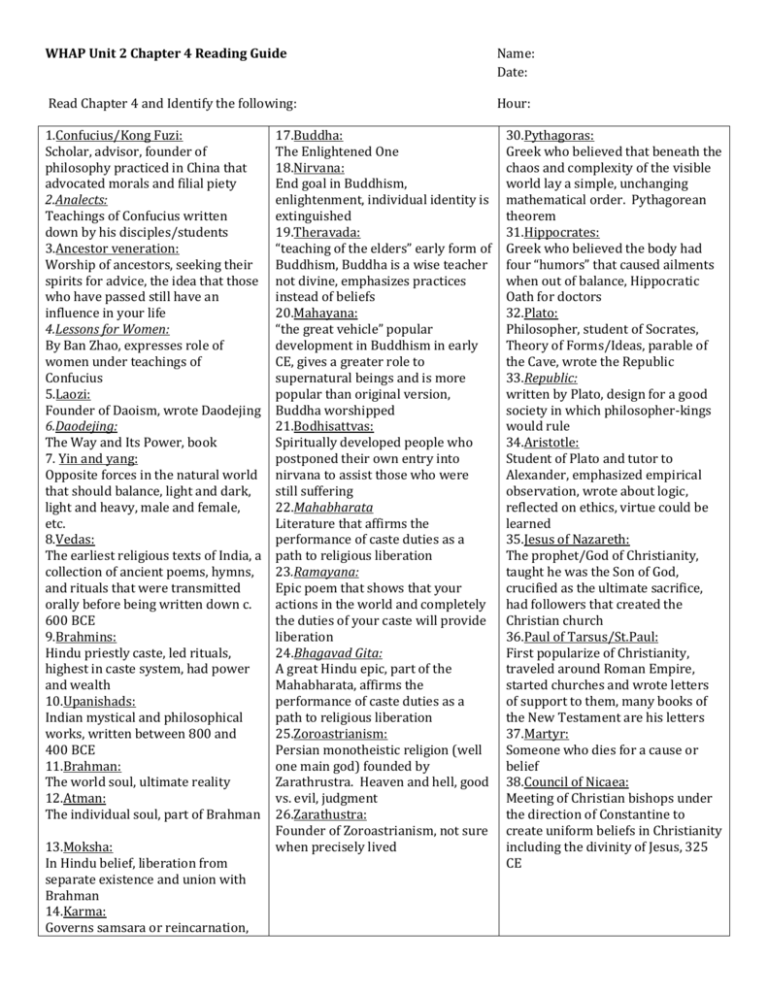
WHAP Unit 2 Chapter 4 Reading Guide Name: Date: Read Chapter 4 and Identify the following: Hour: 1.Confucius/Kong Fuzi: Scholar, advisor, founder of philosophy practiced in China that advocated morals and filial piety 2.Analects: Teachings of Confucius written down by his disciples/students 3.Ancestor veneration: Worship of ancestors, seeking their spirits for advice, the idea that those who have passed still have an influence in your life 4.Lessons for Women: By Ban Zhao, expresses role of women under teachings of Confucius 5.Laozi: Founder of Daoism, wrote Daodejing 6.Daodejing: The Way and Its Power, book 7. Yin and yang: Opposite forces in the natural world that should balance, light and dark, light and heavy, male and female, etc. 8.Vedas: The earliest religious texts of India, a collection of ancient poems, hymns, and rituals that were transmitted orally before being written down c. 600 BCE 9.Brahmins: Hindu priestly caste, led rituals, highest in caste system, had power and wealth 10.Upanishads: Indian mystical and philosophical works, written between 800 and 400 BCE 11.Brahman: The world soul, ultimate reality 12.Atman: The individual soul, part of Brahman 13.Moksha: In Hindu belief, liberation from separate existence and union with Brahman 14.Karma: Governs samsara or reincarnation, 17.Buddha: The Enlightened One 18.Nirvana: End goal in Buddhism, enlightenment, individual identity is extinguished 19.Theravada: “teaching of the elders” early form of Buddhism, Buddha is a wise teacher not divine, emphasizes practices instead of beliefs 20.Mahayana: “the great vehicle” popular development in Buddhism in early CE, gives a greater role to supernatural beings and is more popular than original version, Buddha worshipped 21.Bodhisattvas: Spiritually developed people who postponed their own entry into nirvana to assist those who were still suffering 22.Mahabharata Literature that affirms the performance of caste duties as a path to religious liberation 23.Ramayana: Epic poem that shows that your actions in the world and completely the duties of your caste will provide liberation 24.Bhagavad Gita: A great Hindu epic, part of the Mahabharata, affirms the performance of caste duties as a path to religious liberation 25.Zoroastrianism: Persian monotheistic religion (well one main god) founded by Zarathrustra. Heaven and hell, good vs. evil, judgment 26.Zarathustra: Founder of Zoroastrianism, not sure when precisely lived 30.Pythagoras: Greek who believed that beneath the chaos and complexity of the visible world lay a simple, unchanging mathematical order. Pythagorean theorem 31.Hippocrates: Greek who believed the body had four “humors” that caused ailments when out of balance, Hippocratic Oath for doctors 32.Plato: Philosopher, student of Socrates, Theory of Forms/Ideas, parable of the Cave, wrote the Republic 33.Republic: written by Plato, design for a good society in which philosopher-kings would rule 34.Aristotle: Student of Plato and tutor to Alexander, emphasized empirical observation, wrote about logic, reflected on ethics, virtue could be learned 35.Jesus of Nazareth: The prophet/God of Christianity, taught he was the Son of God, crucified as the ultimate sacrifice, had followers that created the Christian church 36.Paul of Tarsus/St.Paul: First popularize of Christianity, traveled around Roman Empire, started churches and wrote letters of support to them, many books of the New Testament are his letters 37.Martyr: Someone who dies for a cause or belief 38.Council of Nicaea: Meeting of Christian bishops under the direction of Constantine to create uniform beliefs in Christianity including the divinity of Jesus, 325 CE your actions in life affect your reincarnation 15.Law of Manu: Written early centuries CE, Defined women as beholden to men in every phase of life, weak semen generated females 16.Siddhartha Gautama: Indian prince turned ascetic (566486 BCE) found Buddhism, the Buddha 17. Hinduism: Oldest religion in the world that contributed to the development of the social and political roles of a caste system in India and in the importance of multiple manifestations of Brahma to promote teachings about reincarnation/karma. 18. Buddhism: taught by the Buddha were recorded by his followers into sutras and other scriptures (528 B.C.E). 4 Noble Truths of suffering, desire and the search for enlightenment through the 8 fold Path 27.Abraham: Early leader/founder of Hebrew religion, led migration from Mesopotamia to Canaan, made covenant with Yahweh 28.Yahweh: God in Hebrew religion, one sole God 29.Socrates: First Greek philosopher to turn rationalism toward questions of human existence, convicted of immorality/corrupting youth and sentenced to death, taught Plato 32. Shamanism: is a practice that involves a practitioner reaching altered states of consciousness in order to perceive and interact with a spirit world and channel these transcendental energies into this world. 42. Theocracy: Government power that is derived from the religion or spiritual beliefs of the people 43. Jewish Diaspora: The Assyrian, Babylonian, Persian, and Roman empires conquered various Jewish states at different points in time which contributed to the growth of Jewish diasporic communities around the Mediterranean and Middle East. The movement of Jewish people from their homeland of Israel, and city of Jerusalem. 44. Twelve Tables: The codified Roman law that have legal and social rights to plebeians 45. Judaism: Early monotheistic faith of the Hebrews, followed the idea of one god(Yahweh) and they were his chosen people 46. Christianity: Based on core beliefs about the teachings and divinity of Jesus of Nazareth as recorded by his disciples, founded from Judaism 47. Edict of Milan: edict effectively established religious toleration. a proclamation that permanently established religious toleration for Christianity within the Roman Empire. It was the outcome of a political agreement concluded in Milan between the Roman emperors Constantine I and Licinius in February 313. The proclamation, made for the East by Licinius in June 313, granted all persons freedom to worship whatever deity they pleased, assured Christians of legal rights ,including the right to organize churches _____/47 Key Concept 2.1 The Development & Codification of Religious & Cultural Traditions I. Codifications and further developments of existing religious traditions provided a bond among the people and an ethical code to live by. (SUMMARIZE) A. Judaism Hebrew scriptures were codified. They reflected the influence of Mesopotamian culture and legal traditions. The Assyrian, Babylonian, Persian, and Roman empires conquered various Jewish states at different points in time which contributed to the growth of Jewish diasporic communities around the Mediterranean and Middle East. Monotheistic, Yahweh, the Torah, prophets such as Isaiah Sole personal God=Yahweh B. Vedic religions/ Hinduism The core beliefs outlined in the Sanskrit scriptures formed the basis of the Vedic religions---later known as Hinduism---which contributed to the development of the social and political roles of a caste system and in the importance of multiple manifestations of Brahma to promote teachings about reincarnation/karma. Mahabharata, Ramayana, Bhagavad Gita Did not strive for material gain II. New belief systems and cultural traditions (SUMMARIZE) A. Buddhism 528 B.C.E. 4 Noble Truths of suffering, desire and the search for enlightenment through 8 fold Path taught by the Buddha were recorded by his followers into sutras and other scriptures. It was in part a reaction to Vedic beliefs in South Asia. It spread first through support of Mauryan Emperor Ashoka and then by missionaries and merchants. Educational institutions were created. Siddartha Gautama “enlightened one”, Nirvana Mahayana Buddhism=Buddha seen as a god B. Confucianism Kong Fuzi’s teachings and lessons written down by his disciples (Analects)---sought to promote social harmony/restore order by outlining proper rituals and social relationships for all people; in China, Han empire has university and civil service exam; ren, li, xiao (filial piety) Chinese philosophy advocating the moral example of superiors as the key element of social order C. Daoism Belief of balance between humans and nature, Laozi, the way of the cosmos/universe, wuwei (disengage) Go with the flow! influenced medical theories/practices, poetry, metallurgy, architecture Chinese philosophy that advocates simplicity and understanding of the world of nature D. Christianity Based on core beliefs about the teachings and divinity of Jesus of Nazareth as recorded by his disciples, drew from Judaism, and initially rejected Roman and Hellenistic influences. Christianity spread through efforts of missionaries (Paul and Peter) and merchants and gained imperial support (Constantine=legal, Edict of Milan, Theodosius=official) New Testament E. Greco-Roman philosophy and science III. Belief systems affected social roles and structure. Logic, empirical observation, the nature of political power and hierarchy Socrates, Plato, Aristotle; Skepticism, Stoicism, Epicureanism Physics, astronomy, biology, rational humanism A secularizing system of scientific and philosophic thought that developed in classical Greece in the period 600-300 BCE; it emphasized the power of education and human reason to understand the world in nonreligious terms How or in what way did belief systems affect social roles or social structure? Buddhism and Christianity encouraged monastic life and Confucianism emphasized filial piety. Most set patriarchal social structure. Priestesses. Buddhism=wealthy who gave better offerings had better life. Hinduism and caste system IV. Other religious and cultural traditions continued parallel to the codified, written belief systems in core civilizations. B. Ancestor veneration Continued in many regions like East Asia, Africa, Mediterranean, Andean area Ancestor prayers/worship V. Artistic expressions show distinctive cultural developments (Examples in relation to religions?) A. Literature and drama Indian epics/poetry (Mahabharata, Ramayana, Bhagavad Gita) Stories of Greek gods/goddesses in plays, also Homer’s work Holy texts of any of the religions The Analects, the Daodejing, Plato’s The Republic B. Architectural styles Temples Greek columns on temples such as Parthenon, Temple for Athena Doric, Ionic, Corinthian styles= increasingly more elaborate C. Sculpture Of Greek and Roman Gods and goddesses, Buddha statues, of pantheon of Hindu gods Some examples are actually “reliefs” in stone on temples/buildings instead of full statutes Key Concept 2.3 Emergence of Transregional Networks of Communication and Exchange III. More than just goods was exchanged on these networks C. Religious and cultural (Spread of religions over trade routes/networks---who, where, how?) traditions were transformed. Belief systems and traditions were changed/altered as they spread from one region to another, blending Christianity, Hinduism, Buddhism Christianity spread throughout Roman Empire and blended with already practiced religions in empire. Paul of Tarsus Buddhism spread from India into China over Silk Roads. Overtime Buddha will be worshipped as a god. Chapter 4-5 - Big Questions (Short Answer Responses required) 1. Describe how the codification of the Hebrew Scriptures helped to further develop Judaism as a monotheistic religion. The codification of Hebrew Scriptures of the written Torah and the oral traditions of the Talmud are important because they set standard practices and laws for the Jews to follow. The Torah is said to be the laws of Moses given to him by God, they are Genesis, Exodus, Leviticus, Numbers, and Deuteronomy. These further cemented the covenant or contract between the Hebrew people and Yahweh which they gave sole devotion and obedience. 2. The writings of the Sanskrit scriptures formed the basic belief structure and set up the caste systems of the Vedic (later Hindu) religion – it also placed a high importance on Brahma and reincarnation. What is meant by ‘Brahma’ and reincarnation? The Vedas are the ancient Indian text that is the oldest known scripture in the history of the world, these are considered authorless. The Brahma is the god of creation and the Vedic/Hindu religion is based on the belief of reincarnation which is the religious or philosophical concept that your soul or spirit will return after your natural death into a new body. These ideas are infused into the class system of India called the caste (Varna) system. 3. How and why did Buddhism change as it spread across Asia? (map pg. 191) Buddhism was changing as it spread because Buddha teachings were being passed along verbally and Buddha went from being a teacher to the enlightened one, almost god-like. People began to interpret the 4 noble truths and the eight-fold path differently. The political climate in the Gupta Empire which favored Hinduism also pushed out Buddhism which caused it to spread more into Asia. 4. What was the core belief in the major Daoist writings? Did the Daoist writings influence the development of any country? The Daodejing were writings by Loazi that believed that nature governs all natural things, and government was not natural. It influenced the development of China in the Shang, Zhou dynasties and became more of a way of living than a religion. Importance of being one with nature and inner evaluation. It is infused in Chinese culture today to include the practice of Tai Chi which focuses on inner evaluation. 5. Christianity got a rough start in the world – what person does this religion surround? Describe how it spread and became a major world religion. (map pg. 191) Christianity began with Jesus who preached against the teaching of the Jewish priest and there worldly (secular) ways. The religion began under the foundation of the Jewish faith but then branched out to include non-Jews. The religion is based on the belief that Jesus was crucified and resurrected as the son of God and provides salvation and a way to heaven or a relationship with God through Jesus. Jesus’s disciples initially continued his message after his death and then St. Paul was the major apostle that spread the region around the Roman Empire. Eventually the Catholic Church was created which made Christianity the majority religion in Europe after Emperor Constantine converted in eastern Rome and the West fell in 476 AD. 6. Which of the religions mentioned in this chapter emphasized filial piety? What is filial piety? In Confucianism filial piety was the belief that the past is part of the present. It emphasizes respect that must be given to elders, fathers, and ancestors in the form of gifts on shrines and graves. 7. How would you support both sides of this statement? “Religion is a double-edged sword, both supporting and undermining political authority and social elites.” (Answers will very) Religion can be used or misused by governments. Religion can be more important to people than government structure or political rules and power. Religion can provide comfort while political authority provides structure and organization for people. One must also be able to distinguish religion from philosophy. Greek rationalism, Chinese Confucianism and Legalism are all philosophies while Hinduism, Buddhism, Daoism, Zoroastrianism, and Christianity are all religions. Some religions define and support state affairs other go against the power of the state and political authority. 8. In what ways different ways did religious or cultural traditions define purposes of human life? Chinese and Greek thinkers focused more on affairs of this world crediting human reason with the power to guide one to happiness through fulfillment of duty and living a moral life. Indian, Persian, and Jewish religious traditions focused on the divine and relationship to God or gods. Both religious and philosophical approaches provided traditions and task for human that caused personal and spiritual transformation, both of which tended to be compassion. 9. Why was slavery so much more prominent in Greco-Roman civilization than in India or China? Slavery was relied upon as an economic source of free labor in Greek city-states and the Roman Empire, they became a status symbol of power. India and China did not need a free labor source because they had an abundance of peasants in China and India had the outcaste/untouchables and the commoners to do hard labor. Only a few examples of slavery in China and Indian can be seen among the very wealthy people who had them as a status symbol or concubine more so that used for labor. 10. What changes in the patterns of social life in the second-wave of civilization can you identify in Chapters 4-5? What accounts for these changes? The classical era brought no dramatic social changes rather it brought further strengthening of cultural traditions and institutions that reinforced social inequalities such as patriarchy and slavery. Religion helped reinforce these inequalities such as the caste system in India, Confucian and Legalist philosophies in China, and Greek rationalism. _____/10 Identify and briefly describe the following images: Title: The Death of Socrates He was condemned to death by the city-state of Athens for speaking against the political power and forced to drink hemlock/poison. Title: A Bodhisattva of Compassion with 1,000 arms Portrayed as a female who hears the cries of the world. Title: The Chinese Maitreya Buddha Modeled off 10th century Budai(monk), fat and content Buddha considered full of life. Title: Star of David and the Menorah Symbols of Judaism. Menorah is a symbol closely associated with the Jewish holiday of Hanukkah (Chanukah), Star of David is a modern symbol that distinguishing Jews from other ethnic groups. Title: ichthys or ichthus The early Christian church because of the persecution of the Roman Empire was used the fish symbol to mark meeting places and tombs. Title: Om/Aum Hindu symbol that is a sacred sound and a spiritual icon, part of a mantra. Title: Yin and Yang Symbol Traditional Chinese conception of the world stressed two primary forces, good and evil, opposites that worked together to like man and woman that had balance. WHAP Unit 2 Chapter 5 Reading Guide Name: Date: Hour: Read Chapter 5 and identify the following: 1.Emperor Wu Di: Han emperor who established Confucian university and civil service exam 2.Civil Service Examination: Written exam used to select officials in China 3.Bureaucracy: Highly organized institution such as government, many departments 4. Wang Mang: Han court official who usurped the throne and ruled from 8-23; noted for 8.Caste: Class, comes from Portuguese for “race” or “purity of blood” 9.Varna: Four classes originally based on color of skin 10. Brahmin: Priests in Hindu Caste System formed from Purusha’s mouth (white) 11.Kshatriya: Warrior/ruler class in Hindu caste system formed from Purusha’s arms (red) 14.Untouchable: Outside the caste or outcast; those who do jobs that are seen as unclean 15.Jati: Thousands of social distinctions in a caste or varna based on occupation 16.Slavery: Working without pay, no rights, “social death”. In Greek and Roman world, slaves were captives from war and piracy, abandoned children, and the victims of long-distance trade; manumission was common. his reform movement that included the breakup of large estates. 5.Scholar-gentry: Members of China’s landowning families, reflecting their wealth from the land and the privilege that they derived as government officials. 6.Yellow Turban Uprising: Massive Chinese peasant uprising inspired by Daoist teachings that began in 184 CE with the goal of establishing a new golden age of equality and harmony 7.”Great Peace”: Goal of Yellow Turban Uprising, a golden age of equality, social harmony, and common ownership of property 12.Vaisya: Farmers/merchants/artisans in caste system formed from Purusha’s thighs (yellow) 13.Sudra: Laborers in caste system formed from Purusha’s feet (black) Greece=household service most common form. Rome=brutal conditions in mines or plantations 17.Barbarian: seen as lazy, unreliable, immoral, criminal 18.Spartacus: Roman gladiator who led the most serious slave revolt in Roman history (73-71 BCE) 19.Empress Wu: Only female “emperor” in Chinese history (690-705), patronized scholarship, worked to elevate the position of women, and provoked a backlash of Confucian misogynist invective. Key Concept 2.1 The Development & Codification of Religious & Cultural Traditions III. Belief systems affected How or in what way did belief systems affect social roles or social structure? social roles and structure. Key Concept 2.2 Daoism reflected in Yellow Turban Rebellion Hinduism: Aryan beliefs create Caste system. Purusha created them from his body. Good karma and reincarnation to move up caste system. Confucianism: men public but women domestic , “three obedience’s” in which women are subordinate to father, husband, and then son Development of States and Empires III. Unique social and economic dimensions developed in imperial societies in Afro-Eurasia and the Americas B. Social Structures China: state officials were cultural and social elite; although civil service exams favored the wealthy who could educate their children, it was possible for commoners to rise up to the upper class, landowner class; most people were peasants, periodic rebellions; merchants seen as greedy and a social threat who profit off of others India: Caste system, 4 classes (Brahmins, Kshatriyas, Vaisyas, Sudras) Jati in each varna, each jati has duties particular to it, only eat with and marry from your own jati, ostracism if you break rules of jati, Slavery: All civilizations had some form of slavery but seen in abundance in Rome War captives, debtors, criminals Helots in Sparta C. Imperial societies relied on a range of methods to maintain the production of food and provide rewards for the loyalty of elites. Social prestige for and political power for state officials in China, world’s first professional civil service Slavery Duties of caste/jati D. Patriarchy “ownership” of women may have encouraged slavery Patriarchy is more severe in urban areas than in pastoral or agricultural societies Sometimes women could have importance outside of the home China: linked to Confucianism, Ban Zhao wrote about position of women, honor given to mother of sons, dowry was woman’s own property, wife had higher status than concubine, Empress Wu Greece: Athens vs. Sparta in patriarchy---Aristotle said women were inadequate males, women in Athens were supposed to stay indoors out of public life, very few legal rights….. Spartan women not segregated, encouraged to be out in public, exercise, took care of things while husbands away at war. Death in childbirth = death in battle
